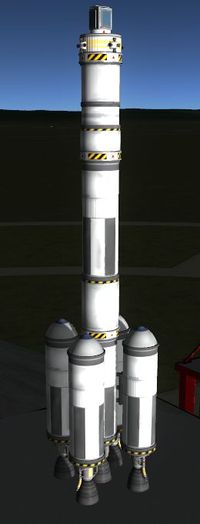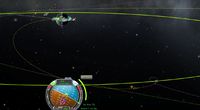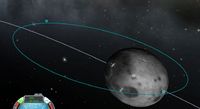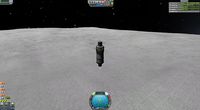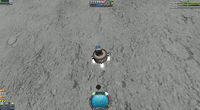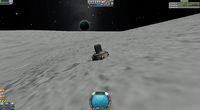Difference between revisions of "Tutorial: Luna 9/zh-cn"
(Create zh-cn page for "Luna 9") |
|||
| Line 41: | Line 41: | ||
** 4x [[LV-T30 Liquid Fuel Engine]] | ** 4x [[LV-T30 Liquid Fuel Engine]] | ||
| − | == | + | == 各任务段 == |
| − | === | + | === 起飞 === |
| − | + | 利用前两级火箭飞行入轨,第三级火箭调整轨道至圆形,并减小与Mün轨道平面的夹角为零。 | |
| − | === | + | === 飞向Mün === |
| − | [[File:Luna-trajectory.jpg|right|200px| | + | [[File:Luna-trajectory.jpg|right|200px|轨道]] |
Get into a transfer orbit just like in the "Going to the Mün" ingame tutorial: Wait until the Mün is 100° ahead of your periapsis and then plan a prograde acceleration maneuver on it which leads you straight to the Mün. Try to find a trajectory which gets you close, but not on a collision course. You can check the closest distance of your course by checking the height of the Mün periapsis. When there is no periapsis marker, you are on a collision course. | Get into a transfer orbit just like in the "Going to the Mün" ingame tutorial: Wait until the Mün is 100° ahead of your periapsis and then plan a prograde acceleration maneuver on it which leads you straight to the Mün. Try to find a trajectory which gets you close, but not on a collision course. You can check the closest distance of your course by checking the height of the Mün periapsis. When there is no periapsis marker, you are on a collision course. | ||
Revision as of 05:11, 4 July 2013
| “ | 我们决定在此十年内登上月球并进行探索,我们以此为目标不是因为它简单,恰恰因为它无比困难。 — John F. Kennedy |
” |
人们在苏联太空计划中常常会忽视“月球”号(Lunik & Luna)系列无人探测器取得的成就。的确,该系列任务遭遇了很多次各种各样的失败,但取得成功的那几次飞行绝对是月球探测飞行的奠基式任务。美国是第一个也是唯一完成载人登月的国家,但第一个到达月球的人造飞行器是“月球”2号(Luna 2),第一幅月球背面的图片是由“月球”3号(Luna 3)拍摄的,第一次完成月面软着陆的飞行器是“月球”9号(Luna 9)。
苏联还成功完成了三次月球采样及返回任务(Luna 16, 20 and 24)。迄今为止,只有苏联人成功实现了利用无人飞船抵达其它天体,完成土壤采样并运载样本返回地球的壮举。然而,这一壮举却因为晚于Apollo 11,而完全被载人登月的光芒所淹没,并没有获得预期中的科学价值。
我们将在本任务中重现Luna 9号的飞行,第一次完成月球软着陆。
Contents
飞行器组成
实际的Luna 9号采用大型充气减震袋来降低着陆时的冲击力。不幸的是,KSP(截至0.18.4)没有此类组件,所以我们将利用火箭着陆来代替实际的方案。
探测器本身尽可能的简单。我们用Probodobodyne QBE作为控制单元。在所有指令类组件中,它可耐受的冲击力最大,因此假如我们的着陆没有成功,它有最大的可能去承受住Mün表面着陆带来的巨大冲击力。它的表面覆盖有OX-STAT Photovoltaic Panels,提供探测器所需要的能源。我们没有加入电池,这意味着探测器在Kerbin或Mün的阴影侧是无法工作的,请牢牢记住这一点。
和苏联太空任务类似,运载火箭是以R-7的设计为基础。“月球”探测器任务的运载火箭与运载Sputnik和加加林进入太空的火箭其实是类似的,只是把火箭再增加一个推进级而已。不过,我还是自作主张的增加了第一级和第三级燃料舱段的容量,考虑到火箭推进技术的各种改进和发展,增强了第三级火箭发动机。其实因为不改就没法完成任务
- 负载级
- 第四级
- 第三级
- 第二级
- 第一级
各任务段
起飞
利用前两级火箭飞行入轨,第三级火箭调整轨道至圆形,并减小与Mün轨道平面的夹角为零。
飞向Mün
Get into a transfer orbit just like in the "Going to the Mün" ingame tutorial: Wait until the Mün is 100° ahead of your periapsis and then plan a prograde acceleration maneuver on it which leads you straight to the Mün. Try to find a trajectory which gets you close, but not on a collision course. You can check the closest distance of your course by checking the height of the Mün periapsis. When there is no periapsis marker, you are on a collision course.
Remember that our probe won't work in the darkness, so make sure that the maneuver is on the daylight side of Kerbin.
After you performed the acceleration maneuver, check your trajectory again to make sure that it really points to the moon and correct if necessary. The earlier you correct your course the less fuel will it cost you. Also don't miss any vertical difference. The best way to correct this is at the ascending/descending node.
Getting into Moon orbit
As soon as you entered the sphere of influence of Mün (you notice because your trajectory suddenly changes) plan a maneuver to get onto a circular orbit. The most efficient way to do this is by boosting retrograde on the Mün periapsis. Again, start your burn a bit early. Our engine isn't the strongest one, so we might need a very long burn duration. When you don't have much fuel left, you might decide to skip orbiting and go for a straight-on collision course the moment you enter the sphere of influence.
Mün has no atmosphere and hasn't got many high mountains, so an orbit of just a few thousand meters is safe and will give you a great view. Maybe you will even spot one of the legendary Mün arches.
Braking maneuver
After you enjoyed the view from orbit it's time to land. Boost retrograde to get onto a course which gets you to the surface. Note that because Mün has no atmosphere, you can control exactly the location where you want to land. Remember the energy problem of our probe: Land on the day side. Also try to land in a very steep angle - it makes the braking maneuver easier.
The most important thing when doing a landing on a planet without an atmosphere is to not lose your nerves and start wasting fuel by braking too early. The faster you go, the less time you spend in the gravity field, and the less speed will be added which you have to kill. The later you brake, the more fuel-efficient will it be. To keep track of how much time you have left, set a maneuver point on the surface.
When you start to panic, go into staging view, face the retrograde marker and boost forward. Watch your speed and try to get it gradually lower. A good rule of thumb is to regulate it so you have 1 m/s for every 100 meter of altitude.
When you almost touch the ground, kill your engine (if it's on while you separate, it will stay on after separation, fly around uncontrolled and possibly hit and damage your probe), release the satellite and maneuver it to the ground using monopropellant.
What next?
Now that you have tasted Mün soil, the next step is obvious: Bring a Kerbal to the Mün and back.
